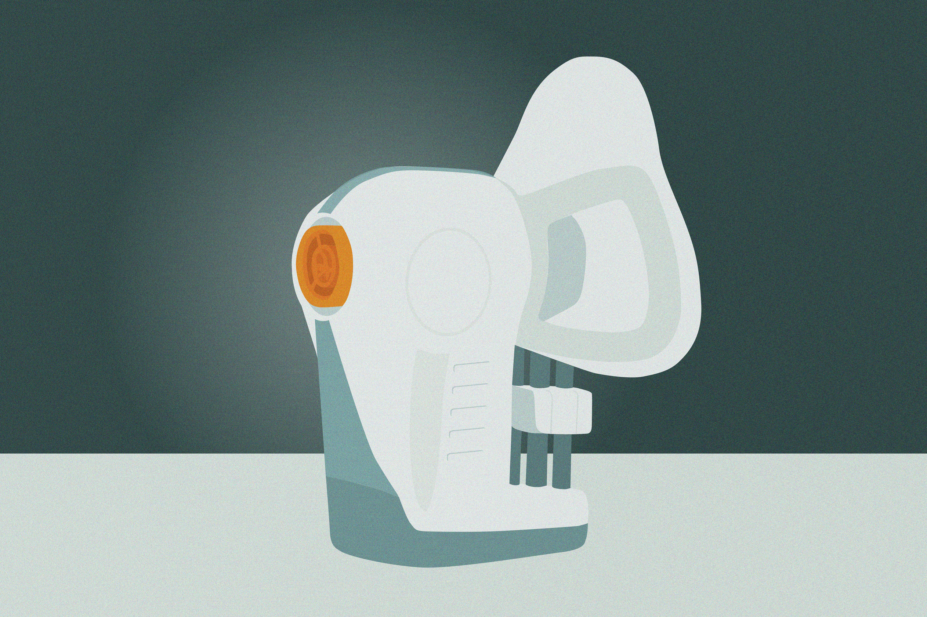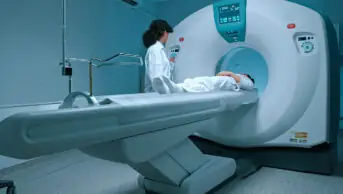
JL / The Pharmaceutical Journal
Few police officers monitoring the roads would be without a breathalyser to gauge the blood alcohol levels of suspected drink-drivers. First introduced to the UK’s roads more than 50 years ago, the technology contributed to a stark fall in drink-driving-related deaths, and has now inspired British healthcare researchers to develop a cheap and noninvasive breath sampler to detect another killer: cancer.
Cambridge-based biotechnology company Owlstone Medical has worked with researchers from Cancer Research UK and the University of Cambridge, and Cambridge University Hospitals NHS Foundation Trust, to launch a 1,500-patient two-year clinical trial of its breath biopsy test for the detection of six different cancers in their early stages[1]
.
The Pan-Cancer Early Detection Study (PAN)[1]
is recruiting patients aged 45 years or over, who have been referred by GPs at Addenbrooke’s Hospital in Cambridge with suspected oesophageal and gastric cancers, as trial cases. Healthy individuals are also being recruited as matched controls for age-, sex- and tumour-specific risk factors. Recruitment will later extend to include patients with prostate, kidney, bladder, liver and pancreatic cancers.
Detecting abnormalities in breath
The breath biopsy test makes use of measuring and analysing volatile organic compounds (VOCs); the compounds, which result from altered metabolism, could indicate the early stages of cancer[2]
,[3]
,[4]
.
The measurement and analysis of VOCs in exhaled breath in relation to many diseases and cancers have been widely studied[5]
,[6]
,[7]
,[8]
,[9]
,[10]
, and the concept has already been translated into several clinical applications[11]
. These include the exhaled nitric oxide test to detect asthmatic airway inflammation[12]
,[13]
; breath tests to detect Helicobacter pylori, which is associated with stomach ulcers and, in certain cases, stomach cancers[14]
; and breath tests for a group of alkanes to identify patients at low risk of heart transplant rejection[15]
.
The PAN trial’s primary aim is to detect these biomarker VOCs in patients’ exhaled breath in the early stages of six cancers and, if possible, use them to discriminate between cancers.
Advanced technology
One minute of breathing into the breathalyser can collect exhaled breath with known biomarker VOCs, or ten minutes for the discovery of new biomarker VOCs. The process is pain free and noninvasive — unlike current liquid and tissue biopsies, which can be distressing for patients. The sampler is equipped with internal, fast-response carbon dioxide pressure sensors that improve the quality of the collected exhaled breath samples for analysis involving the most advanced techniques to date. The breath biopsy takes around 72 hours to process, from collection to the detection of established cancer biomarker VOCs — roughly the same amount of time as other laboratory or cancer-detection tests. Blood work may take days or sometimes weeks.
The breath biopsy platform has the potential to detect signature VOCs that relate to multiple inflammatory diseases, infectious diseases and possibly multiple cancers. The test aims to provide a ‘live snapshot’ of a person’s ‘metabolome’; in other words, the person’s metabolism or chemical status at a certain point in time. The technology can also be used to measure exposure to hazardous substances and monitor drug metabolism.
A breath test with positive cancer biomarkers can aid patients’ early referral from GPs to specialised care for further investigation and treatment
Building a biomarker database
The developes hope to establish a database of signature VOCs that could be significantly correlated with inflammatory diseases, infectious diseases and cancer. Additionally, this method may have the potential to identify biomarker VOCs of certain types of cancer and to form the world’s largest biobank of exhaled breath samples matched to patient phenotype, as well as annotated health records and prospective analyses of VOCs in breath. The database, by maturing into a comprehensive biomarker VOC dictionary available to many healthcare professionals, could hold great potential to aid disease detection across the world.
Saving more lives and cutting treatment costs
In 2014, cancer treatments cost US patients nearly US$4bn[16]
. From 2010–2015, cancer services cost the UK NHS around £18.3bn each year[17]
. And Cancer Research UK estimates that nearly £210m of the NHS budget could be saved if cancer was diagnosed earlier[18]
.
The World Health Organization estimated that, each year, cancer costs the lives of 8.8 million people, the vast majority of whom are diagnosed too late[19]
. The National Institute for Health and Care Excellence estimated that 5,000 lives could be saved each year in England if cancer is diagnosed earlier[20]
, while one study estimates that 5,000–10,000 deaths occurring within five years of cancer diagnosis could be avoided every year[21]
.
There is a clear need for earlier detection of cancer, which saves lives and enormous costs to patients and healthcare systems. A tool that can aid earlier cancer detection — and one that is more acceptable to patients than current techniques — could help to reduce the impact of cancer. In the long term, the developers of the breath biopsy hope the test will become available “in any place, not just the hospital” and widely accessible to healthcare professionals in primary care.
There is also scope for using the test to monitor recurrent cancer
Patients with early-stage cancer, who are asymptomatic or display non-cancer-specific symptoms, can greatly benefit from the advancement; a breath test with positive cancer biomarker VOCs can aid patients’ early referral from GPs to specialised care for further investigation and treatment. VOCs in breath have been shown to be a biomarker for recurrent colorectal cancer in a study of postsurgery patients, meaning there is also scope for using the test to monitor recurrent cancer[22]
.
Navigating the unknowns
While the VOC concept and new technology are compelling, until the trial reports, several questions are left unanswered. How specific will these signature VOCs be to different cancer types? Will the VOCs overlap with other existing cancers or noncancer diseases? And patients with which kinds of cancer are most likely to benefit from this new tool? Will the tool be restricted to only oesophago-gastric and pulmonary-related cancers, or will it extend beyond?
The PAN trial will test the hypothesis that some VOCs will fall across cancers in general, and some more specifically. The breathalyser would be a great success if it was able to identify any cancer, but the researchers are especially interested in cancers that are hard to diagnose (and usually diagnosed late), hence the trial’s inclusion of oesophago-gastric cancers, and later pancreatic and liver cancers.
Previous studies on exhaled breath tests in relation to cancer detection have varied in method of breath collection, method of analysis, patient health status and testing environment. Standardisation of method, and the results of larger studies paired with external validations, should strengthen the VOC–breath concept, and speed up the development and availability of this technology to healthcare professionals detecting cancer on the front line.
Balkees Abderrahman is a fellow of cancer research, University of Texas MD Anderson Cancer Center
Correspondence to:
bhabderrahman@mdanderson.org
References
[1] ClinicalTrials.gov. PAN-study: Pan-cancer early detection study (PAN). 2018. Available at: https://clinicaltrials.gov/ct2/show/NCT03756597 (accessed February 2019)
[2] Pavlova NN & Thompson CB. The emerging hallmarks of cancer metabolism. Cell Metab 2016;23(1):27–47. doi: 10.1016/j.cmet.2015.12.006
[3] Gaude E & Frezza C. Tissue-specific and convergent metabolic transformation of cancer correlates with metastatic potential and patient survival. Nat Commun 2016;7:13041. doi: 10.1038/ncomms13041
[4] Tennant DA, Duran RV, Gottlieb E. Targeting metabolic transformation for cancer therapy. Nat Rev Cancer 2010;10(4):267–277. doi: 10.1038/nrc2817
[5] Phillips M, Gleeson K, Hughes JMB et al. Volatile organic compounds in breath as markers of lung cancer: a cross-sectional study. Lancet 1999;353(9168):1930–1933. doi: 10.1016/S0140-6736(98)07552-7
[6] Kumar S, Huang JZ, Abbassi-Ghadi N et al. Mass spectrometric analysis of exhaled breath for the identification of volatile organic compound biomarkers in esophageal and gastric adenocarcinoma. Ann Surg 2015;262(6):981–990. doi: 10.1097/Sla.0000000000001101
[7] Altomare DF, Di Lena M, Porcelli F et al. Exhaled volatile organic compounds identify patients with colorectal cancer. Brit J Surg 2013;100(1):144–151. doi: 10.1002/bjs.8942
[8] Peng G, Hakim M, Broza YY et al. Detection of lung, breast, colorectal, and prostate cancers from exhaled breath using a single array of nanosensors. Brit J Cancer 2010;103(4):542–551. doi: 10.1038/sj.bjc.6605810
[9] Phillips M, Cataneo RN, Cruz-Ramos JA et al. Prediction of breast cancer risk with volatile biomarkers in breath. Breast Cancer Res Tr 2018;170(2):343–350. doi: 10.1007/s10549-018-4764-4
[10] Markar SR, Wiggins T, Antonowicz S et al. Assessment of a noninvasive exhaled breath test for the diagnosis of oesophagogastric cancer. JAMA Oncology 2018;4(7):970–976. doi: 10.1001/jamaoncol.2018.0991
[11] Paschke KM, Mashir A, Dweik RA. Clinical applications of breath testing. F1000 Med Rep 2010;2:56. doi: 10.3410/M2-56
[12] Kharitonov SA, Yates D, Robbins RA et al. Increased nitric oxide in exhaled air of asthmatic patients. Lancet 1994;343(8890):133–135. PMID: 7904001
[13] Silkoff PE, Carlson M, Bourke T et al. The Aerocrine exhaled nitric oxide monitoring system NIOX is cleared by the US Food and Drug Administration for monitoring therapy in asthma. J Allergy Clin Immun 2004;114(5):1241–1256. doi: 10.1016/j.jaci.2004.08.042
[14] Graham DY, Klein PD, Evans DJ Jr et al. Campylobacter pylori detected noninvasively by the 13C-urea breath test. Lancet 1987;1(8543):1174–1177. PMID: 2883491
[15] Phillips M, Boehmer JP, Cataneo RN et al. Heart allograft rejection: detection with breath alkanes in low levels (the HARDBALL study). J Heart Lung Transplant 2004;23(6):701–708. PMID: 15366430
[16] Cancer Action Network, American Cancer Society. The costs of cancer: addressing patient costs. 2017. Available at: https://www.fightcancer.org/sites/default/files/Costs%20of%20Cancer%20-%20Final%20Web.pdf (accessed February 2019)
[17] Department of Health and Social Care. 2010 to 2015 government policy: cancer research and treatment. 8 May 2015. Available at: https://www.gov.uk/government/publications/2010-to-2015-government-policy-cancer-research-and-treatment/2010-to-2015-government-policy-cancer-research-and-treatment (accessed February 2019)
[18] Incisive Health, Cancer Research UK. Saving lives, averting costs: An analysis of the financial implications of achieving earlier diagnosis of colorectal, lung and ovarian cancer. September 2014. Available at: https://www.cancerresearchuk.org/sites/default/files/saving_lives_averting_costs.pdf (accessed February 2019)
[19] World Health Organization. Early cancer diagnosis saves lives, cuts treatment costs. 3 February 2017. Available at: https://www.who.int/news-room/detail/03-02-2017-early-cancer-diagnosis-saves-lives-cuts-treatment-costs (accessed February 2019)
[20] National Institute for Health and Care Excellence. NICE’s new symptom-based approach will help to save thousands of lives from cancer. 23 June 2015. Available at: https://www.nice.org.uk/news/article/nice-s-new-symptom-based-approach-will-help-to-save-thousands-of-lives-from-cancer (accessed February 2019)
[21] Richards MA. The size of the prize for earlier diagnosis of cancer in England. Br J Cancer 2009;101 Suppl 2:S125–129. doi: 10.1038/sj.bjc.6605402
[22] Markar SR, Chin ST, Romano A et al. Breath volatile organic compound profiling of colorectal cancer using selected ion flow-tube mass spectrometry. Ann Surg 2017. doi: 10.1097/SLA.0000000000002539


